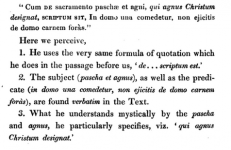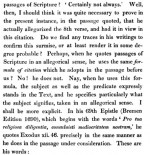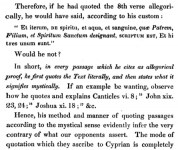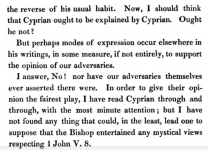Steven Avery
Administrator
This Post:
Cyprian - no invisible allegorizing
https://www.purebibleforum.com/inde...ion-no-invisible-allegorizing.2135/#post-8108
Original Title
Cyprian pre-answered the Facundus allegorical explanation - no invisible allegorizing
However, I have removed the pre-answered part, because that is a weakness in Knittel and Forster.
Changed to
Cyprian - no invisible allegorizing
And we can add that there is no invisible allegorizing by any New Testament writer.
====================================
A New Plea
Charles Forster
https://books.google.com/books?id=EKwCAAAAQAAJ&pg=PA65
=============================
Nec argumentis plurimis opus est, frater carissime, ut probemus appellatione aquae Baptisma significatum semper esse, et sic nos intelligere debere.
There is no need for very many arguments, dear brother, to prove that baptism was always meant by the name of water, and so we ought to understand it.
=============================
Knittel and Forster are not really using this properly. It is a stretch to say that this sentence would prevent any allegorical sense for baptism.
=============================
It is Epistle 63
The Latin section needs English placement in the Cyprian text, p. 707
(However, since the argument is weak, we can let it pass.)
https://archive.org/details/CorpusScriptoruEcclesiasticorumLatinorum3.2Cyprian/page/n255/mode/2up

======================================
The Knittel part is in p. 21-24
And Knittel and Forster are pointing out that there is NO invisible allegorizing.
======================================
Sander - says 38 Epistle
https://books.google.com/books?id=KAwWAAAAYAAJ&pg=PA267
======================================
Knittel
https://books.google.com/books?id=QH5CAAAAIAAJ&pg=PA24




Cyprian - no invisible allegorizing
https://www.purebibleforum.com/inde...ion-no-invisible-allegorizing.2135/#post-8108
Original Title
Cyprian pre-answered the Facundus allegorical explanation - no invisible allegorizing
However, I have removed the pre-answered part, because that is a weakness in Knittel and Forster.
Changed to
Cyprian - no invisible allegorizing
And we can add that there is no invisible allegorizing by any New Testament writer.
====================================
A New Plea
Charles Forster
https://books.google.com/books?id=EKwCAAAAQAAJ&pg=PA65
Having further shown of Cyprian that, ‘in every passage which he cites as allegorical proof, he first quotes the text literally, and then states what it signifies mystically;' this learned writer proceeds to produce a passage which alone proves it impossible that Cyprian could have understood the eighth verse of the Trinity.

Cyprian, therefore, declares it to be unscriptural for any one to believe that water, in the Bible, occasionally represents a Person of the Godhead.’
=============================
Nec argumentis plurimis opus est, frater carissime, ut probemus appellatione aquae Baptisma significatum semper esse, et sic nos intelligere debere.
There is no need for very many arguments, dear brother, to prove that baptism was always meant by the name of water, and so we ought to understand it.
=============================
Knittel and Forster are not really using this properly. It is a stretch to say that this sentence would prevent any allegorical sense for baptism.
=============================
It is Epistle 63
The Latin section needs English placement in the Cyprian text, p. 707
(However, since the argument is weak, we can let it pass.)
https://archive.org/details/CorpusScriptoruEcclesiasticorumLatinorum3.2Cyprian/page/n255/mode/2up
======================================
The Knittel part is in p. 21-24
And Knittel and Forster are pointing out that there is NO invisible allegorizing.
======================================
Sander - says 38 Epistle
https://books.google.com/books?id=KAwWAAAAYAAJ&pg=PA267
======================================
Knittel
https://books.google.com/books?id=QH5CAAAAIAAJ&pg=PA24
Last edited:





